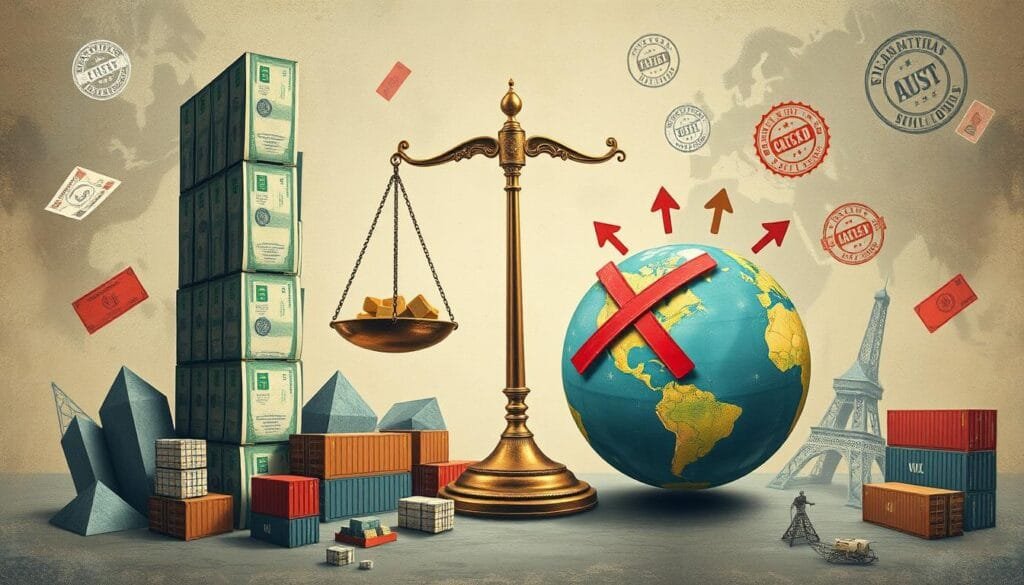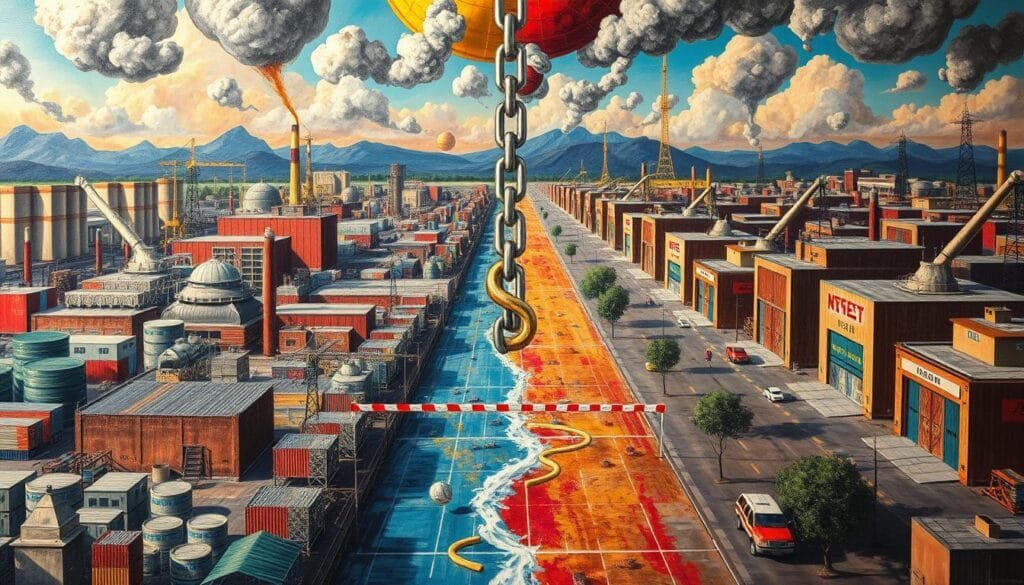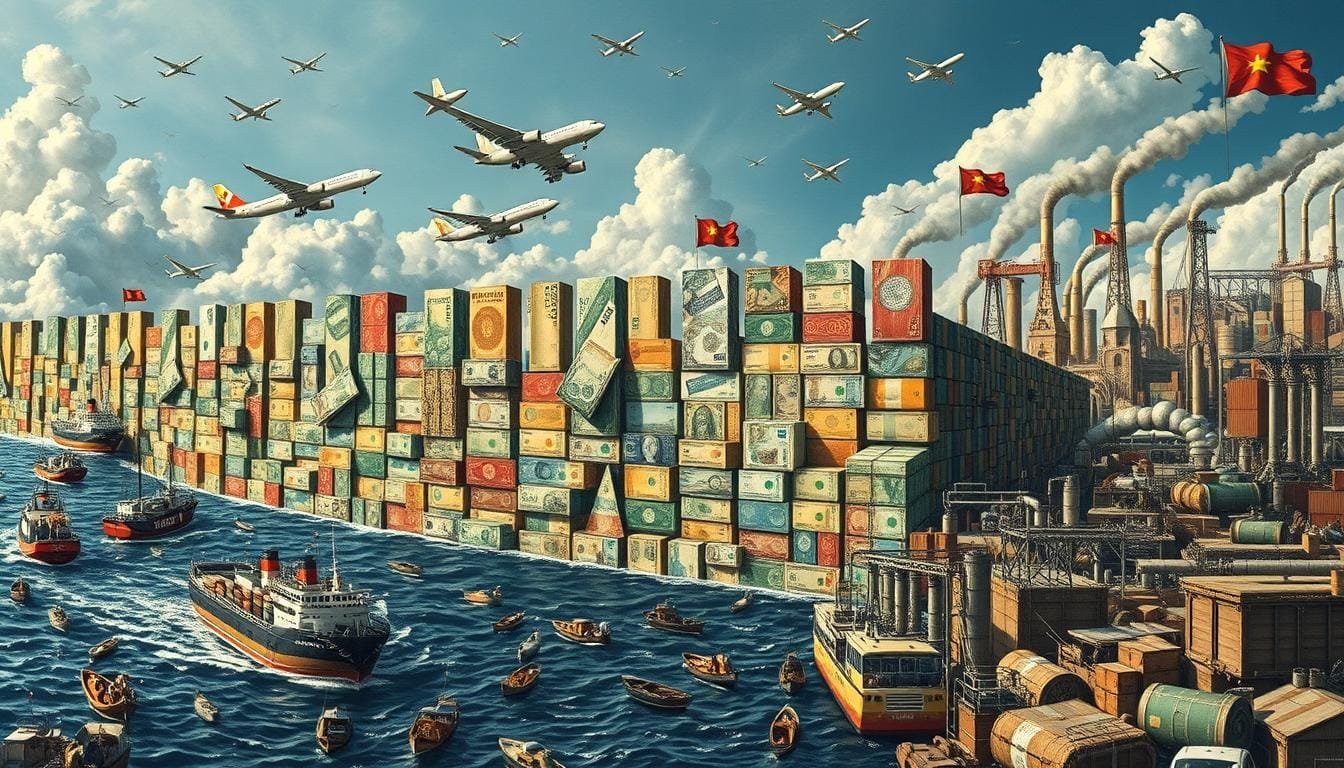Ever wonder why some countries put taxes and limits on trade from abroad? Let’s explore the complex world of trade barriers. These are key factors that affect global trade and economies all over. Trade barriers like tariffs and quotas shape economic policies and consumer markets.
Key Takeaways
- Trade barriers are tools used by governments to regulate international trade.
- The main goal of trade barriers is to safeguard local industries and jobs.
- Types of trade barriers include tariffs, quotas, licenses, and voluntary export restraints (VER).
- These barriers impact consumers, local industries, and how much money governments make.
- Even though they’re meant to help, trade barriers can have mixed effects on the economy.
Introduction to Trade Barriers
Trade barriers play a big role in international trade. They can change how countries trade with each other. Let’s explore what these barriers mean and why they’re important.
Definition of Trade Barriers
Trade barriers are limits set by governments on international trade. They can be tariffs, quotas, or import licenses. These barriers make it harder for foreign products to enter a country’s market. By understanding defining trade barriers, we see their effect on world trade and relations.
Purpose of Trade Barriers
The purpose of economic barriers is complex. Their main goal is to protect local industries from global competition. This helps to keep jobs in the country and protect growing industries. Besides, barriers can also be used for political reasons, security, or to counter unfair trade.
For example, in the 1980s, trade between East Asian countries grew. This happened as these countries set different trade rules within their region.
Types of Trade Barriers
It’s vital to know the different types of trade barriers. They play a key role in how countries handle international trade. You’ll find several types, each affecting trade in its own way.
Tariffs
Tariffs are taxes on imports. They make foreign goods cost more than local ones. This helps protect local businesses but may increase prices for shoppers. The Uruguay Round was a big deal for tariffs, opening up trade in services and textiles too.
Quotas
Quotas limit how much of a product can enter a country. They affect how much is available in the market and its price. In the 1980s, areas like East Asia and Europe saw trade grow, showing how quotas work.
Licenses
To import some products, you need a trade license. These licenses control which goods can enter a market. They keep standards high and help local industries compete against foreign ones.
Voluntary Export Restraints (VER)
With VERs, countries limit their own exports. This is to avoid harsher trade barriers. NAFTA is an example where the U.S. and Mexico used VERs to keep trade smooth.
What Does Trade Barriers Mean in Economics?
In economics, trade barriers are limits set by countries. They control international trade. Forms include tariffs, quotas, and licenses. They matter a lot for both local and worldwide markets. Knowing the economic definition of trade barriers helps us understand global trade better.

Trade barriers affect many parts of the economy. For example, tariffs make imported goods cost more. This makes local products more appealing. It can lead to more exports than imports, or the reverse. The trade restrictions impact sectors like retail and manufacturing by changing prices and what goods are available.
Barriers also limit how much trade happens internationally. International trade limits affect how many and what kinds of goods can be traded. Imports from certain countries show the competition level and market dynamics worldwide.
| Statistic | Details |
|---|---|
| Retail Institutions | Only 0.25% of U.S. retail institutions are department stores, yet they account for approximately 9% of all retail store sales. |
| Market Concentration | Approximately 20% of the $40 billion retail volume in the U.S. is dominated by 25 large corporations. |
| Corporate Control | 16 large corporations directly control about 10% of the retail volume. |
| Retail Business Control | 10% of the retail business is indirectly controlled by three leading automobile manufacturers and five large integrated oil companies. |
| Mail-Order Sales | Sears Roebuck & Co. and Montgomery Ward & Co. generated a combined sales volume of about $1 billion, equating to over 2% of all retail sales in the U.S. |
These facts show how trade limits shape markets and economic actions. The move towards controlled trade shows the complexity of today’s economies. Studying these points helps us get deeper insights into trade barriers in economics.
Impact of Trade Barriers on Domestic Economy
Trade barriers affect our economy in many ways. They touch everything from what we pay for items to how well our industries do. Understanding their impact helps us see the big economic picture they create.
Effects on Consumers
When trade barriers go up, the cost of goods and services jump. This means people can buy less and might not be as happy. Consumers might have to choose local products that cost more, leaving them less money to spend on other things.
Take electronics for example. If tariffs hit, prices go up. This hits buyers in their wallets. It cuts down spending, which could slow down how fast our economy grows.
Effects on Domestic Industries
Trade barriers can make local industries feel safe from international competition at first. But, there’s a downside. If there’s no competition, industries might not try to get better or more efficient.
Look at Beatrice Foods Co. They’ve grown a lot because they haven’t faced much foreign competition. But, without this pressure, companies might not keep growing. So while some businesses might do well for a while, the bigger picture shows our industries could fall behind.

Government Revenue Implications
Tariffs can bring in a lot of money for governments. This cash can help pay for things like roads and schools. But, this money comes at a cost. Higher prices can make consumers unhappy and hurt domestic producers in the long run.
Even though more government money sounds good, it’s not that simple. The whole economy feels the effects of trade barriers, from how much things cost to how competitive our industries are.
Reasons for Implementing Trade Barriers
Various factors like economy, politics, and society influence trade barriers. Understanding these factors helps us grasp how they shape global trade.
Protecting Domestic Employment
Protecting jobs within a country is a main reason for trade barriers. Governments use tariffs or quotas to help local industries compete against international firms. This can keep employment steady, even though it may raise prices and reduce options for consumers. Keeping jobs at home is essential for a country’s economic health and social well-being.
Protecting Infant Industries
Trade barriers aid the growth of infant industries. New industries in developing nations struggle against larger foreign competitors. Protective measures give them time and support to develop. This is crucial for spurring innovation and technological progress at home.

Ensuring National Security
Trade barriers are vital for national security. Industries critical to defense and infrastructure must be shielded from foreign control. Using trade barriers to protect these industries keeps a nation’s autonomy and security intact.
Anti-dumping Measures
Countries use anti-dumping laws to prevent unfair competition. These laws keep foreign companies from selling goods at very low prices to hurt local businesses. Anti-dumping measures ensure fair competition and uphold market integrity.
| Reason | Description | Benefit |
|---|---|---|
| Protecting Domestic Employment | Shielding local industries from international competition. | Maintains employment levels, economic stability. |
| Protecting Infant Industries | Allowing new industries to grow without overwhelming competition. | Fosters innovation and domestic technological advancement. |
| Ensuring National Security | Protecting critical industries to prevent foreign dependency. | Safeguards a country’s autonomy and security interests. |
| Anti-dumping Measures | Enforcing laws against foreign producers selling below cost. | Promotes fair trade and maintains a level playing field. |
Pros and Cons of Trade Barriers
When we talk about trade barriers, we need to look at the good and bad sides. It’s important to see how these policies affect our economy. They touch everything from local businesses to global relationships.
Advantages of Trade Barriers
Trade barriers come with several upsides. They help keep jobs in the country, protect new industries, bring in money for the government, and ensure national safety.
- Protecting Domestic Employment: By limiting foreign competition, trade barriers keep jobs at home. For instance, exported products support one in six U.S. manufacturing jobs.
- Protecting Nascent Industries: They give new industries a chance to grow. This is really important in tech and green energy areas.
- Generating Government Revenue: Tariffs are a big help for the government’s budget. Back in 1985, U.S. exports and imports made significant financial contributions.
- Ensuring National Security: Trade barriers reduce dependence on foreign goods. This keeps vital sectors like defense and energy safe from global supply problems.
Disadvantages of Trade Barriers
On the flip side, economic barriers have downsides. They can lead to higher prices, fewer choices, trade tensions, and slow growth.
- Higher Prices for Consumers: Tariffs make imported goods cost more. For example, jeans that cost $20 in the U.S. were $90 in Poland because of these restrictions.
- Limited Product Choices: Barriers can reduce the products available, hurting competition and innovation. This was clear in the 1980s agricultural market crash.
- Potential Retaliation from Trade Partners: Countries hit by barriers might fight back with their own. The U.S. saw a big increase in foreign investment in the 1980s.
- Stunted Economic Growth: Too many barriers can block growth. It’s important to find a middle ground. The right balance encourages a strong economy, as shown in studies like the trade policy implications.
| Category | 1985 Value (in billion $) |
|---|---|
| Total U.S. Exports | 147.3 |
| Total U.S. Imports | 359.9 |
| U.S. Exports of Food, Feed, and Beverages | 23.9 |
| U.S. Imports of Fuels | 10.2 |
| U.S. Imports of Machinery | 18.0 |
| U.S. Imports of Electrical Goods | 59.2 |
| U.S. Imports of Cars | 22.9 |
In summary, weighing the pros and cons of trade barriers is critical. We need to strike a balance. This approach helps protect our economy while limiting the downsides for consumers and global trade. For more insights, the Trade Adjustment Assistance program has comprehensive reports.
Conclusion
Trade barriers play a big role in the world’s economy, affecting both local and global markets. When looking at trade policies, it’s important to consider the good and bad sides. They have a big impact on a country’s economic growth, the cost of goods for consumers, and overall wellbeing.
In the 1980s, there was a big change in trade within regions. For example, trade in East Asia went up from 23% to 29%. Europe’s internal trade increased from 54% to 60%. Agreements like the Uruguay Round and NAFTA have changed how countries trade with each other. They aimed to make trading easier by lowering trade barriers. However, they also brought new challenges, such as higher transportation costs and effects on market welfare.
Trade barriers and economic barriers have two sides. They can protect local industries and keep a country safe. But, high tariffs and strict limits on trade can make things worse. They can lead to higher prices for shoppers and hurt global welfare. As we study global trade, understanding both sides of these policies is crucial. This helps us see their short and long-term effects on the world economy.
FAQ
What are trade barriers?
Trade barriers are rules set by governments to control international trade. These include tariffs, quotas, licenses, and voluntary export restraints (VER).
What is the purpose of trade barriers?
Trade barriers protect local businesses from overseas competition. They also support national safety and can increase government income through certain charges.
How do tariffs affect global trade?
Tariffs make imported goods more expensive. They reduce imports, help the government earn money, and support local businesses. However, they might increase prices for buyers and provoke trade wars.
What are import quotas?
Import quotas limit how many goods can enter a country. They can reduce availability, change prices, and protect local companies from global rivals.
How do licenses function as trade barriers?
Licenses control the entry of certain imports. They keep local industries safe and ensure that imports meet quality and safety standards.
What are Voluntary Export Restraints (VER)?
VERs are deals to limit goods exported to certain countries. They’re made to prevent stricter limits or tariffs by the importing nation.
What is the economic impact of trade barriers?
Trade barriers can safeguard jobs and industries, and make money for governments. Yet, they can also increase prices, limit choices, and slow down the economy.
Why are trade barriers implemented?
They’re used to protect jobs, promote new sectors, ensure safety, and stop the flood of cheap foreign goods that could damage local businesses.
What are the advantages of trade barriers?
Benefits include job protection, help for new industries, national security, government income, and defense against low-priced imports.
What are the disadvantages of trade barriers?
Drawbacks include higher costs for consumers, fewer options, possible trade revenge, less economic efficiency, and hindered growth for local sectors.
